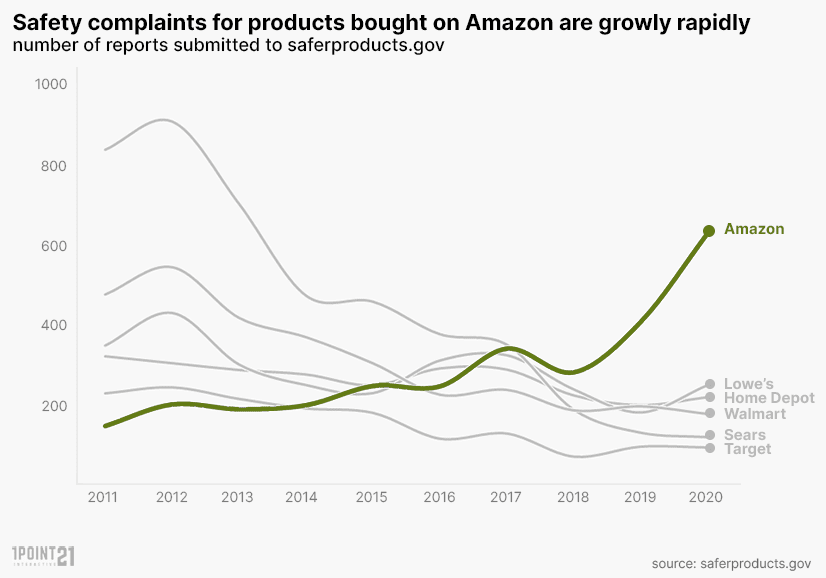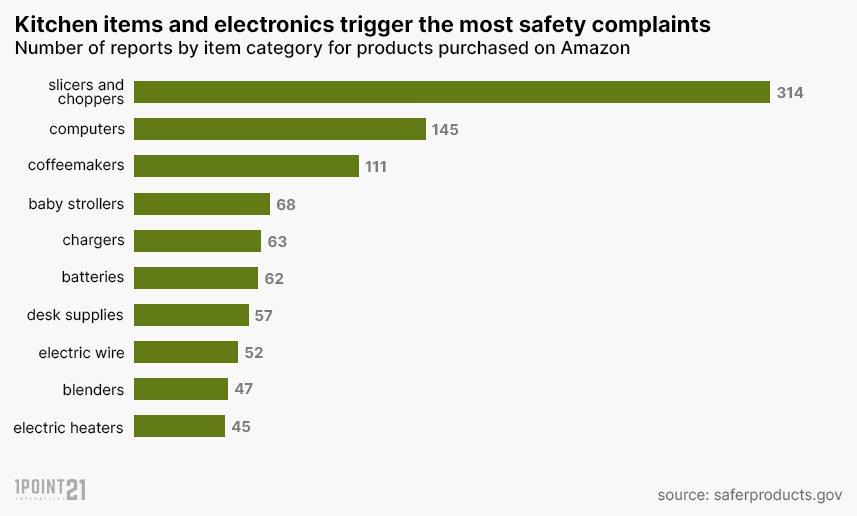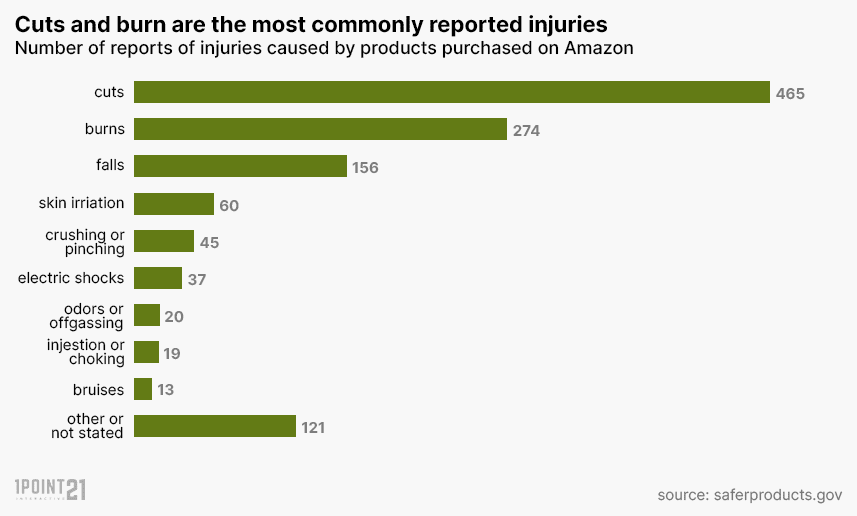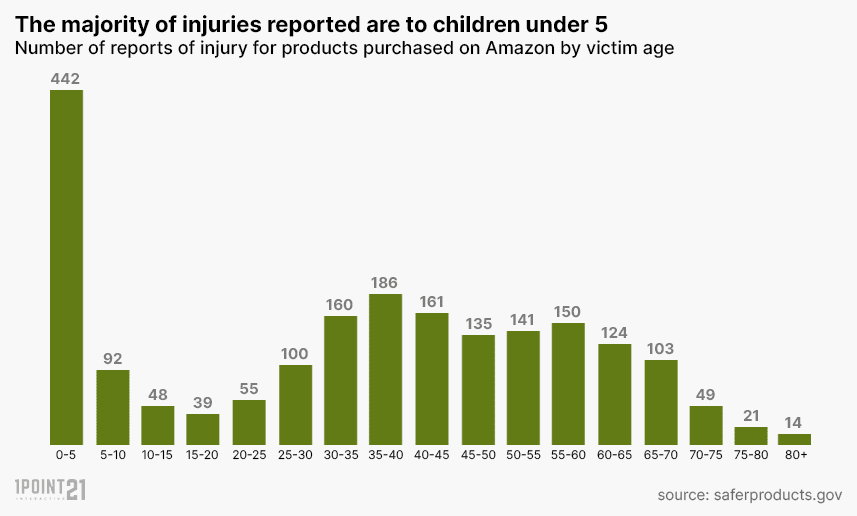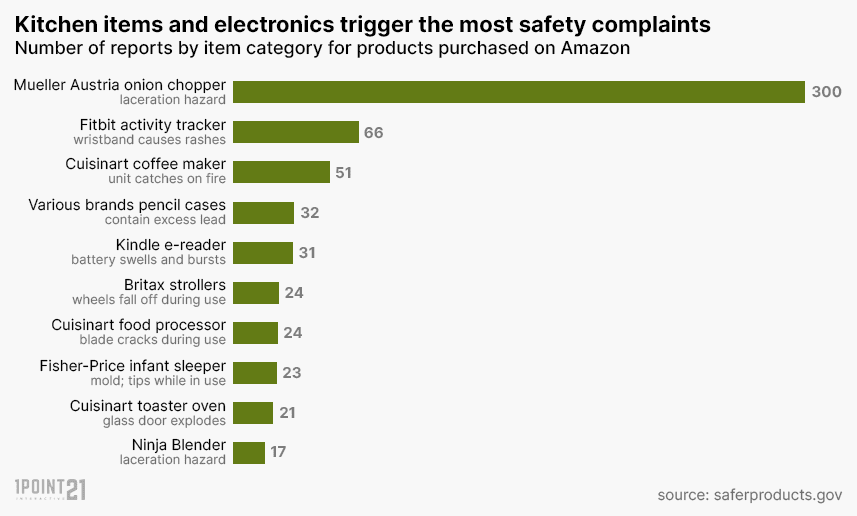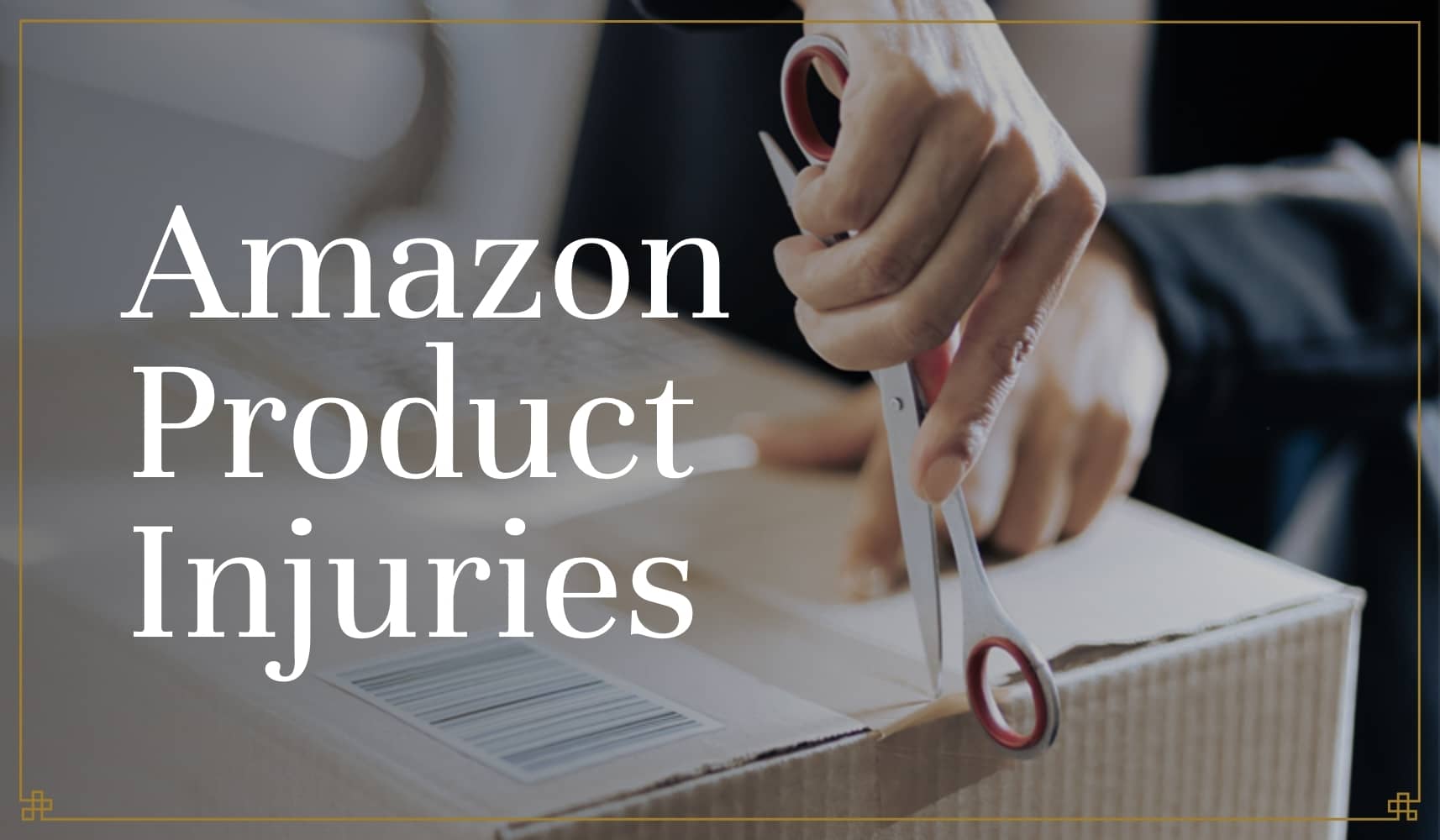
Amazon is the largest online retailer in the world, delivering over $386 billion dollars worth of products to customers in 2020. While the retail giant lists and sells millions of products, millions more are listed and sold by third-party sellers. While this expands the market for consumers, it has also led to a spike in the sale of counterfeit, fake, and unsafe products and increased the potential risk from products that Amazon hasn’t properly regulated.
We have likely all received a product that doesn’t resemble its photograph, but the repercussions are much more serious when the product is unsafe or listed under false pretense.
In a recent investigation, the Wall Street Journal revealed that 4,152 items listed on Amazon were found unsafe by federal agencies, deceptively labeled, or banned by federal regulators. Out of those, 2,000 listings were for toys and medications that did not warn of potential health risks to children. This led us to examine the safety complaints involving Amazon products.
We examined data from the United States Consumer Product Safety Commission to find out how often consumers report being injured by products purchased on Amazon and how accurately Amazon reviews represented their products. From 2011 – 2020, the USCPSC received a total of 2,998 safety complaints about Amazon products.
Is Amazon adequately warning consumers of their product’s potential risks, or are consumers blind-sided?
The data shows that seven percent of all safety complaints on Saferproducts.gov are about products purchased on Amazon and the most reported products are electronics, and kitchen items, such as slicers and choppers. In these reported instances, the reviews posted on Amazon’s website did not always reflect the potential risks and there was – and is – more to the story than meets the eye.
How does Amazon compare with other retailers?
During the entire timeframe we examined, Amazon ranked third behind Walmart and Sears with 2,998 safety complaints.
| Retailer | Safety Complaints | Percent of Total |
|---|---|---|
| Walmart | 5980 | 13% |
| Sears | 4570 | 10% |
| Amazon | 2998 | 7% |
| Home Depot | 2781 | 6% |
| Lowes | 2720 | 6% |
| Target | 1502 | 3% |
| Best Buy | 1492 | 3% |
| Costco | 558 | 1% |
| Babies R Us | 470 | 1% |
| Bed Bath and Beyond | 444 | 1% |
However, in recent years, complaints about Amazon products have grown exponentially – taking over the top spot. In 2020, Amazon had nearly three times as many safety complaints as the next closest retailer, Lowe’s.
From 2018 to 2020, the number of complaints about Amazon products nearly doubled, while complaints about other retailers stayed around the same. Since 2018, Amazon hasn’t just been the #1 online retailer, but also the #1 retailer for consumer safety complaints.
Which Amazon products receive the most safety complaints?
As previously mentioned, Amazon’s most reported products turned out to be kitchen items (such as slicers and choppers) and electronics (such as computers, equipment, and electronic games). Slicers and choppers make up ten percent of all Amazon safety complaints.
| Product Type | n | pct |
|---|---|---|
| Slicers and Choppers | 314 | 10% |
| Computers (Equipment and Electronic Games) | 145 | 5% |
| Electric Coffee Makers or Teapots | 111 | 4% |
| Baby Strollers | 68 | 2% |
| Battery Chargers/Adapters | 63 | 2% |
| Batteries | 62 | 2% |
| Desk Supplies | 57 | 2% |
| Electric Wire or Wiring Systems | 52 | 2% |
| Electric Blenders | 47 | 2% |
| Portable Electric Heaters | 45 | 2% |
| Electric Counter-top Ovens, Broilers or Toaster Ovens | 45 | 2% |
How are People Injured by Products Purchased on Amazon?
A product can cause injury in a wide range of ways, even under normal use. However, according to complaint data, cuts (465) and burns (274) are by far the most common. Falls were the third leading cause of injury (156) and 121 reports did not state the type of injury.
Who Is Most Often Injured?
As is often the case with consumer product injuries, children are significantly over-represented in the safety complaint data. In fact, 442 of the total Amazon complaints involved children aged five and under – the most of any age group.
Which Specific Products Have Caused the Most Injuries?
While this data is incomplete and only comes from injured customers who file complaints, a few products were overwhelmingly overrepresented in the data. The Mueller Onion Chopper was identified in 300 reports, followed by Fitbit Activity Trackers with 66, and Cuisinart Coffee Maker with 51.
| # reports | Category | Item | Complaint | Recalled? | Still listed? |
|---|---|---|---|---|---|
| 300 | Slicers and Choppers (469) | Mueller Onion Chopper | Can cause deep cuts | Y | Y; presumably fixed after recall |
| 66 | Personal Fitness/Activity Trackers (5038) | Fitbit activity tracker | Wristband causes rashes | n | Y |
| 51 | Electric Coffee Makers or Teapots (217) | Cuisinart coffee maker | Fire hazard | n | Y |
| 32 | Desk Supplies (1650) | Pencil cases | Lead in excess of federal regulations | n | Y; at least one is still listed, but others have been taken down |
| 31 | Computers (Equipment and Electronic Games) (557) | Kindle | Charger casing flakes off, exposing wires. Battery swells and expands. | n | Y |
| 24 | Baby Strollers (1522) | Britax stroller/car seats | Pieces fall off, leading to hazards | y | Y; presumably fixed after recall |
| 24 | Food Processors (275) | Cuisinart food processor | Blade can break and leave metal in food | y | Y; presumably fixed after recall |
| 23 | Bassinets or Cradles (1537) | Fisher-Price RocknPlay sleeper | Mold growth; tipping while in use | Y; recalled for suffocating infants (but reports from saferproducts.gov are about more minor issues) | N |
| 21 | Electric Counter-top Ovens, Broilers or Toaster Ovens (216) | Cuisinart toaster oven | Fire hazard; glass in door explodes | n | Y |
| 17 | Electric Blenders (215) | Ninja Blender | Laceration hazard | Y | Y; presumably fixed after recall |
*Listing status data as of 3/1/22
Example 1: Mueller Austria Onion Chopper
At first glance, the Mueller Austria Onion Chopper looks like the ideal Amazon purchase. It received an overall Amazon rating of 4.5, and over 985 written reviews –77 percent of them a glowing 5 stars. But the reviews omit what you need to know most.
The onion slicer was sold on Amazon from September 2016 to July 2020, and it caused more reports of injury than any other item purchased from Amazon. The product was recalled on October 29, 2020, after involving 266 incidents where the product’s locking tab detached from the rest of the unit and caused the user’s fingers and hands to slide into the blade. This resulted in as many as 137 laceration injuries to the fingers and hands. 38 of the injuries resulted in trips to the emergency room or doctor. The first safety complaint, however, was reported more than a year ago: September 6, 2019.
While the manufacturer has corrected the problem, people continue to report problems through Amazon reviews. The issue is there are dozens of nearly identical-looking onion choppers on Amazon, and while the Mueller chopper has been recalled and fixed, these other choppers have not. Amazon allows sellers to sell the same product under different brands as long as the seller can prove it is their product. However, this can lead to fake brands selling the same generic product on Amazon.
We reviewed 10 popular alternatives to the Mueller chopper and found that every one of them had reviews mentioning users cutting themselves while using or washing the chopper. 15 reviewers had to go to the hospital due to the injuries they sustained from these slicers, and one reviewer said they cut their finger off in the process. Clearly, we can see that when reviews aren’t completely honest, not only are they misleading to consumers, but they risk harming them, too. Amazon can add a warning to state that a similar product had consumer safety complaints to increase consumer awareness.
Example 2: Various brands of pencil pouch
Like the onion chopper, the Boonafit Pencil Pouch has a 4.5 Amazon rating. It only has two written reviews. One says the pencil pouch is sturdy, and the other says it isn’t made with the best quality. But what the reviews – and Amazon won’t tell you – is that an investigation by the Washington Attorney General’s Office found that a variety of pencil cases exceed federal limits for lead. A Boonafit pencil case tested at 20 times the federal limit. While it isn’t clear whether this is the exact pencil case tested by the Attorney General, this pencil case is from the same brand and fits the general description of the problematic case. It’s important to note that other pencil cases have been removed, but this case is still available.
Example 3: Flex Seal Rubber Spray
The Flex Seal Rubber Spray has 825 written reviews and a 4.3 Amazing rating. But the reviews conveniently leave out a product’s safety concern. According to a saferproducts.gov report, a can of Flex Seal spontaneously ignited during use, burning the face, hands, and arms of the consumer. The consumer went to the emergency room and was hospitalized in the burn unit. In addition to this, four reviews on Amazon mention the product catching on fire or exploding, but none of these reviews are easily found. The first mention of this doesn’t appear until page 30. Reviews with safety concerns should be highlighted for consumer awareness, not be buried.
Can Amazon be held responsible for products from third-party sellers?
The answer appears to be yes – depending on the state. In the past decade, over 60 federal lawsuits have been brought against Amazon related to its responsibility for the harm caused by these products.
For a long time, Amazon referred to itself as only an ‘intermediary between buyers and third-party sellers.’ They argued that since it was only a platform connecting third-party sellers with consumers, it did not bear responsibility for the injuries consumers suffered. Recent litigation, however, challenged – and rejected – Amazon’s long-held stance.
Lawsuit Against Amazon: Bolger v. Amazon.com, LLC
In August 2020, the California Court of Appeals ruled that under California law, Amazon can be held responsible for selling a defective product from a third-party seller on its website. In the federal court case, Bolger v. Amazon.com LLC, Angela Bolger suffered burn injuries from a battery that caught fire. The battery was listed on the Amazon Marketplace by a Chinese vendor under the fake name of “E-Life.”
As mentioned above, Amazon can be held responsible for a third-party seller’s defective product – depending on the state. In Bolger v. Amazon.com, LLC, Angela Bolger suffered severe burns when a replacement laptop battery she had bought on Amazon exploded. The California Court of Appeal reversed its original judgment and ruled in 2020 that under California law, Amazon can be strictly liable for an allegedly defective battery manufactured by a third party and sold on its website. This marked the first appellate opinion in the country where Amazon was held liable for defective products sold on its website.
The court reasoned that regardless of what Amazon calls itself – a facilitator, distributor, retailer, its role was “pivotal” in bringing the product to the consumer, and therefore, it could not evade responsibility for the injuries that resulted from the defective product. It stated that Amazon directly connected Bolger to the defective battery by taking the following actions:
- Accepting the product from the seller
- Storing it in an Amazon warehouse
- Attracting Bolger to the product on its website
- Providing Bolger with a product listing
- Receiving her payment for the product
- Shipping the product in Amazon packaging to her
What can you do to stay ahead of fake reviews and products?
In 2020, Amazon “seized and destroyed” 2 million counterfeit products. In addition, the company stated that it invests over $700 million and employs more than 10,000 people to prevent bad actors and bad products. Still, counterfeiting remains an issue and has only gotten worse over the pandemic. When you buy a product on Amazon, you are relying on their reputation and expect a safe and reliable product. While it is Amazon’s responsibility to catch and remove fake reviews and products, what can we do to better protect ourselves when we are buying products?
- Use Fakespot, a tool that analyzes billions of reviews to quickly identify suspicious activity and recommend better alternatives to consumers.
- Make sure to switch from “top reviews” to “most recent” reviews.
- Review Saferproducts.gov, so you know more of the story – and not just what Amazon or third-party sellers want you to know.
- Be skeptical: Look at not only the rating but the number of reviews that create the rating.

